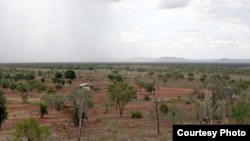Higher levels of carbon-dioxide has caused some of the Earth’s most arid regions to become more green, according to new research.
Scientists focused on the American southwest, Australia’s outback, the Middle East and parts of Africa, and found that from 1982 to 2010 there was a “fertilization effect” caused by increased carbon-dioxide levels.
Researchers predicted foliage would increase by 5 to 10 percent given the 14 percent increase in atmospheric CO2 concentration during the study period. The satellite data agreed, showing an 11 percent increase in foliage after adjusting the data for precipitation variations, according to a study published by the American Geophysical Union.
The use of satellite imagery was key to the findings.
“Satellites are very good at detecting changes in total leaf cover, and it is in warm, dry environments that the CO2 effect is expected to most influence leaf cover,” said Randall Donohue of the Commonwealth Scientific and Industrial Research Organization (CSIRO) in Canberra, Australia, who led the effort.
Donohue added that leaf cover is a clue because “a leaf can extract more carbon from the air during photosynthesis, or lose less water to the air during photosynthesis, or both, due to elevated CO2.”
“If elevated CO2 causes the water use of individual leaves to drop, plants will respond by increasing their total numbers of leaves, and this should be measurable from satellite,” he said.
The scientists say they were able to isolate the effects of CO2 from other factors like precipitation, air temperature, the amount of light and land-use changes.
This was done by first averaging out the greenness levels of each location over 3-year periods to account for changes in soil wetness, for example. They then predicted the maximum amount of foliage that could be attained with the given precipitation along with other climatic variations to see the long-term greening effect of CO2.
The research also said that the fertilization effect could lead to different types of vegetation dominating the dry regions.
“Trees are re-invading grass lands, and this could quite possibly be related to the CO2 effect,” Donohue said. “Long lived woody plants are deep rooted and are likely to benefit more than grasses from an increase in CO2.”
While the researchers say the effects of fertilization as a result of higher CO2 levels need more study, it will likely lead to “significant environmental changes,” even if nothing else in the climate changes said Donohue.
Scientists focused on the American southwest, Australia’s outback, the Middle East and parts of Africa, and found that from 1982 to 2010 there was a “fertilization effect” caused by increased carbon-dioxide levels.
Researchers predicted foliage would increase by 5 to 10 percent given the 14 percent increase in atmospheric CO2 concentration during the study period. The satellite data agreed, showing an 11 percent increase in foliage after adjusting the data for precipitation variations, according to a study published by the American Geophysical Union.
The use of satellite imagery was key to the findings.
“Satellites are very good at detecting changes in total leaf cover, and it is in warm, dry environments that the CO2 effect is expected to most influence leaf cover,” said Randall Donohue of the Commonwealth Scientific and Industrial Research Organization (CSIRO) in Canberra, Australia, who led the effort.
Donohue added that leaf cover is a clue because “a leaf can extract more carbon from the air during photosynthesis, or lose less water to the air during photosynthesis, or both, due to elevated CO2.”
“If elevated CO2 causes the water use of individual leaves to drop, plants will respond by increasing their total numbers of leaves, and this should be measurable from satellite,” he said.
The scientists say they were able to isolate the effects of CO2 from other factors like precipitation, air temperature, the amount of light and land-use changes.
This was done by first averaging out the greenness levels of each location over 3-year periods to account for changes in soil wetness, for example. They then predicted the maximum amount of foliage that could be attained with the given precipitation along with other climatic variations to see the long-term greening effect of CO2.
The research also said that the fertilization effect could lead to different types of vegetation dominating the dry regions.
“Trees are re-invading grass lands, and this could quite possibly be related to the CO2 effect,” Donohue said. “Long lived woody plants are deep rooted and are likely to benefit more than grasses from an increase in CO2.”
While the researchers say the effects of fertilization as a result of higher CO2 levels need more study, it will likely lead to “significant environmental changes,” even if nothing else in the climate changes said Donohue.









